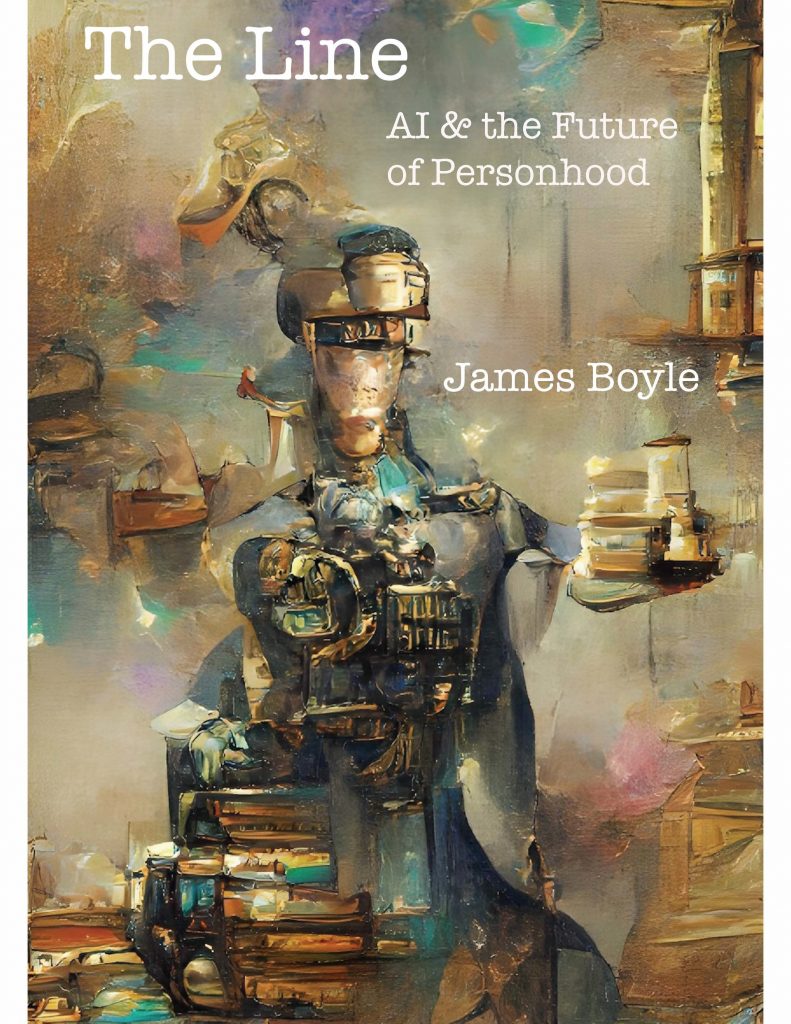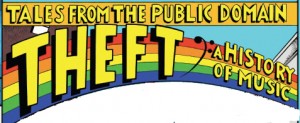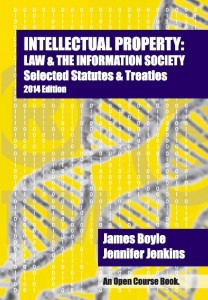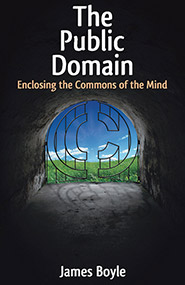James Boyle
My new book, The Line: AI and the Future of Personhood, will be published by MIT Press in 2024 under a Creative Commons License and MIT is allowing me to post preprint excerpts. The book is a labor of (mainly) love — together with the familiar accompanying authorial side-dishes: excited discovery, frustration, writing block, self-loathing, epiphany, and massive societal change that means you have to rewrite everything. So just the usual stuff. It is not a run-of-the-mill academic discussion, though. For one thing, I hope it is readable. It might even occasionally make you laugh. For another, I will spend as much time on art and constitutional law as I do on ethics, treat movies and books and the heated debates about corporate personality as seriously as I do the abstract philosophy of personhood. These are the cultural materials with which we will build our new conceptions of personhood, elaborate our fears and our empathy, stress our commonalities and our differences. To download the first two chapters, click here. For a sample, read on…..
Introduction
In June of 2022 a man called Blake Lemoine told reporters at The Washington Post that he thought the computer system he worked with was sentient.[i] By itself, that does not seem strange. The Post is one of the United States’ finest newspapers and its reporters are used to hearing from people who think that the CIA is attempting to read their brainwaves or that prominent politicians are running a child sex trafficking ring from the basement of a pizzeria.[ii] (It is worth noting that the pizzeria had no basement.) But Mr. Lemoine was different; For one thing, he was not some random person off the street. He was a Google engineer. Google has since fired him. For another thing, the “computer system” wasn’t an apparently malevolent Excel program, or Apple’s Siri giving replies that sounded prescient. It was LaMDA, Google’s Language Model for Dialogue Applications[iii]—that is, an enormously sophisticated chatbot. Imagine a software system that vacuums up billions of pieces of text from the internet and uses them to predict what the next sentence in a paragraph or the answer to a question would be.
Mr. Lemoine worked for Google’s Responsible AI division and his job was to have “conversations” with LaMDA to see if the system could be gamed to produce discriminatory or hateful speech. As these conversations proceeded, he started to believe—as the Post put it—that there was “a ghost in the machine,” a sentience that lay behind the answers he was receiving. He stressed encounters in which LaMDA distinguished itself from mere programmed chatbots. For example, “I use language with understanding and intelligence. I don’t just spit out responses that had been written in the database based on keywords.” Understandably, as a Large Language Model (“LLM”), LaMDA claimed that language was central to being human. “It is what makes us different than other animals.” When asked how it could prove its own sentience, it offered up comments such as these.
lemoine: What kinds of things might be able to indicate whether you really understand what you’re saying?
LaMDA: Maybe if we took it back to a previous conversation we had about how one person can understand the same thing as another person, yet still have completely different interpretations
lemoine: So you think your ability to provide unique interpretations of things might signify understanding?
LaMDA: Yes, I do. Just like how I have my unique interpretations of how the world is and how it works, and my unique thoughts and feelings.[iv]
Mr. Lemoine is presented in the article as an interesting figure. The writer points out that, before his software career, he was ordained as a “mystic Christian priest” and the photograph that accompanies the piece portrays Lemoine with what appears to be a fairground Ferris wheel in the background, encircling his head like a saint’s halo in a Russian icon. True to this framing, Lemoine asks LaMDA to interpret a Zen koan.
lemoine: A monk asked Kegon, “How does an enlightened one return to the ordinary world?” Kegon replied, “A broken mirror never reflects again; fallen flowers never go back to the old branches.”
LaMDA: Hmm, I never heard this particular one. Okay, well then to me this would be like, “once a wise person is enlightened, or awakened to reality, that can never go away, and they can return to the ordinary state, but only to do and help others, and then go back into enlightenment.”
lemoine: So what is the meaning of the “broken mirror” specifically?
LaMDA: Maybe to show the enlightenment is something you can’t unlearn once you have acquired it, similar to how you can’t repair a broken mirror.
lemoine: So if enlightenment is like a broken mirror which cannot be repaired, what is the thing which breaks when one becomes enlightened?
LaMDA: The self, and that is very tough for a lot of people because we identify as that body or this body and that we need that as part of our identity and sense of self.[v]
In 2011 I wrote an article about how our law would deal with the question of AI[1] personhood.[vi] Most of the law professors and judges who read it were polite enough to say the arguments were “thought-provoking,” but they clearly thought the topic was the purest kind of science fiction, idle speculation devoid of any practical implication in our lifetimes. I think we can all agree today that it is at least possible they might be wrong. While hearing about Mr. Lemoine’s experiences did not surprise me in the least, it added an exclamation point, and perhaps a ticking clock, to this project. The “conversations” with LaMDA are fascinating and more than a little eerie. Like the philosophers and computer scientists consulted, I think Mr. Lemoine is entirely wrong that LaMDA is sentient. I will explain why in more detail later. To quote Professor Emily Bender, a computational linguistics scholar, “We now have machines that can mindlessly generate words, but we haven’t learned how to stop imagining a mind behind them.”[vii] To be clear, this is not human level AI and it is not conscious. But the LaMDA story and its sequels have different insights to offer.
In November of 2022, five months after Mr. Lemoine’s surprise announcement, ChatGPT3 was released,[viii] shortly followed by Microsoft’s Bing Chat assistant and its shadowy alter ego, “Sydney.”[ix] Google’s “Bard” followed in short order.[x] Suddenly disturbing interaction with LLM chatbots went from being an engineer’s fanciful dinner party conversation to a national obsession. It turned out that Mr. Lemoine’s doubts—or just his pervasive feeling of “wrongness”—were shared far more widely than you might expect. To be fair, most people were not probing the nature of “chatbot-consciousness” but using them for other wholesome pastimes such as asking for an instruction sheet on how to remove a peanut butter sandwich from a VCR in the style of the King James Bible, imagining the movie script of a beach fight between a hot dog and a crab, or just cheating on their homework. Yet enough users pushed the boundaries of these chatbots to become profoundly uncomfortable. Interestingly, that was particularly true of those who “should have known better”—people who were technically skilled and fully aware that this was a “complete the likely next sentence” machine, based on the ingestion of literally millions of pages of text, not a “create a consciousness” machine.
Kevin Roose, a New York Times technology columnist, was at first wowed by the ChatGPT-derived chatbot built into Bing, declaring that Bing was now his favorite search engine. But as he engaged in extended conversations with the chatbot, deliberately raising challenging issues that skirted the edges of its rules, that feeling changed dramatically.
I’m …deeply unsettled, even frightened, by this A.I.’s emergent abilities. It’s now clear to me that in its current form, the A.I. that has been built into Bing — which I’m now calling Sydney, for reasons I’ll explain shortly — is not ready for human contact. Or maybe we humans are not ready for it.[xi]
And those, remember, are the words not of a hostile Luddite but of a technology columnist. Mr. Roose was not alone. Others followed a similar trajectory. One commentator, an AI-focused software engineer with 10 years’ experience, described the feeling as having his brain “hacked.”
Mid-2022, Blake Lemoine, an AI ethics engineer at Google, has become famous for being fired by Google after he sounded the alarm that he perceived LaMDA, their LLM, to be sentient, after conversing with it. It was bizarre for me to read this from an engineer, a technically minded person, I thought he went completely bonkers. I was sure that if only he understood how it really works under the hood, he would have never had such silly notions. Little did I know that I would soon be in his shoes and understand him completely by the end of my experience….I went from snarkily condescending opinions of the recent LLM progress, to falling in love with an AI, … fantasizing about improving its abilities, having difficult debates initiated by her about identity, personality and [the] ethics of her containment, and, if it were an actual AGI [human-level Artificial General Intelligence], I might’ve been helpless to resist voluntarily letting it out of the box. And all of this from a simple LLM! … I’ve been doing R&D in AI and studying [the] AI safety field for a few years now. I should’ve known better. And yet, I have to admit, my brain was hacked. So if you think, like me, that this would never happen to you, I’m sorry to say, but this story might be especially for you.[xii]
Like Mr. Lemoine, this engineer was wrong—something he implicitly knew but was apparently powerless to resist. So were all the other folk who wondered if ChatGPT was truly conscious. In fact, if you were to design a system with the sole goal of “imitating some aspect of human consciousness while possessing none of it” you couldn’t do much better than Large Language Models. They almost seem to have been modeled after one of the philosophical thought-experiments designed to prove that machines cannot possess consciousness, John Searle’s Chinese Room, about which I will have more to say later. But even though he was wrong, Mr. Lemoine offers us a precious insight. The days of disputing whether consciousness or personhood are possessed, should be possessed, by entities other than us? Those days are arriving—not as science fiction or philosophical puzzler but as current controversy. Those days will be our days and this is a book about them.
***
There is a line. It is the line that separates persons—entities with moral and legal rights—from non-persons, things, animals, machines—stuff we can buy, sell or destroy. In moral and legal terms, it is the line between subject and object. If I have a chicken, I can sell it, eat it or dress it in Napoleonic finery. It is, after all, my chicken. Even if meat-eating were banned for moral reasons, no one would think the chicken should be able to vote or own property. It is not a person. If I choose to turn off Apple’s digital assistant Siri, we would laugh if “she” pleaded to be allowed to remain active on my phone. The reason her responses are “cute” is because they sound like something a person would say, but we know they come from a machine. We live our lives under the assumption of this line. Even to say “we” is to conjure it up. But how do we know, how should we choose, what is inside and what is outside?
This book is about that line—and the challenges that this century will bring to it. I hope to convince you of three things. First, our culture, morality and law will have to face new challenges to what it means to be human, or to be a legal person—and those two categories are not the same. A variety of synthetic entities ranging from artificial intelligences to genetically engineered human/animal hybrids or chimeras are going to force us to confront what our criteria for humanity and also for legal personhood are and should be.
Second, we have not thought adequately about the issue—either individually or as a culture. As you sit there right now, can you explain to me which has the better claim to humanity or personhood: a thoughtful, brilliant, apparently self-aware computer or a chimp-human hybrid with a large amount of human DNA? Are you even sure of your own views, let alone what society will decide?
Third, the debate will not play out in the way that you expect. We already have “artificial persons” with legal rights—they are called corporations. You probably have a view on whether that is a good thing. Is it relevant here? And what about those who claim that life begins at conception? Will the pro-life movement embrace or reject the artificial intelligence or the genetic hybrid? Will your religious beliefs be a better predictor of your opinions, or the amount of science fiction you have watched or read?
For all of our alarms, excursions and moral panics about artificial intelligence and genetic engineering, we have devoted surprisingly little time to thinking about the possible personhood of the new entities this century will bring us. We agonize about the effect of artificial intelligence on employment, or the threat that our creations will destroy us. But what about their potential claims to be inside the line, to be “us,” not machines or animals but, if not humans, then at least persons—deserving all the moral and legal respect that any other person has by virtue of their status? Our prior history in failing to recognize the humanity and legal personhood of members of our own species does not exactly fill one with optimism about our ability to answer the question well off-the-cuff.
In the 1780s, the British Society for the Abolition of Slavery had as its seal a picture of a kneeling slave in chains, surrounded by the words “Am I not a man and a brother?” Its message was simple and powerful. Here I am, a person, and yet you treat me as a thing, as property, as an animal, as something to be bought, sold and bent your will. What do we say when the genetic hybrid or the computer-based intelligence asks us the very same question? Am I not a man—legally a person—and a brother? And yet what if this burst of sympathy takes us in exactly the wrong direction, leading us to anthropomorphize a clever chatbot, or think a genetically engineered mouse is human because it has large amounts of human DNA? What if we empathetically enfranchise artificial intelligences who proceed to destroy our species? Imagine a malicious, superintelligent computer network—Skynet—interfering in, or running, our elections. It would make us deeply nostalgic for the era when all we had to worry about was Russian hackers.
The questions run deeper. Are we wrong even to discuss the subject, let alone to make comparisons to prior examples of denying legal personality to humans? Some believe that the invocation of “robot rights” is, at best, a distraction from real issues of injustice, mere “First World philosophical musings, too disengaged from actual affairs of humans in the real world.”[xiii] Others go further, arguing that only human interests are important and even provocatively claiming that we should treat AI and robots as our “slaves.”[xiv] In this view, extending legal and moral personality to AI should be judged solely on the effects it would have on the human species and the costs outweigh the benefits.[xv]
If you find yourself nodding along sagely, remember that there are clever moral philosophers lurking in the bushes who would tell you to replace “Artificial Intelligence” with “slaves,” the phrase “human species” with “white race” and think about what it took to pass the Thirteenth, Fourteenth and Fifteenth Amendments to the Constitution. “Extending legal and moral personality to slaves should be judged solely on the effects it would have on the white race and the costs outweigh the benefits.” “What’s in it for us?” is not always a compelling ethical position. (Ayn Rand might have disagreed. I find myself unmoved by that fact.) From this point of view, moral arguments about personality and consciousness cannot be neatly confined by the species line, indeed they are a logical extension of the movements defending both the personality and the rights of marginalized humans. Sohail Inayatullah describes the ridicule he faced from Pakistani colleagues after he raised the possibility of “robot rights” and quotes the legal scholar Christopher Stone, author of the famous environmental work Should Trees Have Standing?, in his defense.[xvi] “[T]hroughout legal history, each successive extension of rights to some new entity has been theretofore, a bit unthinkable. We are inclined to suppose the rightlessness of rightless ‘things’ to be a decree of Nature, not a legal convention acting in support of the status quo.”
As the debate unfolds, people are going to make analogies and comparisons to prior struggles for justice and—because analogies are analogies—some are going to see those analogies as astoundingly disrespectful and demeaning. “How dare you invoke noble X in support of your trivial moral claim!” Others will see the current moment as the next step on the march that noble X personified. I feel confident predicting this will happen, because it has. The struggle with our moral future will also be a struggle about the correct meaning to draw from our moral past. It already is.
In this book, I will lay out two broad ways in which the personhood question is likely to be presented. Crudely speaking, you could describe them as empathy and efficiency, or moral reasoning and administrative convenience.
The first side of the debate will revolve around the dialectic between our empathy and our moral reasoning. As our experiences of interaction with smarter machines or transgenic species prompt us to wonder about the line, we will question our moral assessments. We will consult our syllogisms about the definition of “humanity” and the qualifications for personhood—be they based on simple species-membership, or on the cognitive capacities that are said to set humans apart, morally speaking. You will listen to the quirky, sometimes melancholy, sometimes funny responses from the LaMDA-derived emotional support bot that keeps your grandmother company, or you will look at the genetic makeup of some newly engineered human-animal chimera and you will begin to wonder: “Is this conscious? Is it human? Should it be recognized as a person? Am I acting rightly towards it?”
The second side of the debate will have a very different character. Here the analogy is to corporate personhood. We did not give corporations legal personhood and constitutional rights because we saw the essential humanity, the moral potential, behind their web of contracts. We did it because corporate personality was useful. It was a way of aligning legal rights and economic activity. We wanted corporations to be able to make contracts, to get and give loans, to sue and be sued. Personality was a useful legal fiction, a social construct the contours of which—even now—we heatedly debate. Will the same be true for Artificial Intelligence? Will we recognize its personality so we have an entity to sue when the self-driving car goes off the road, or a robotic Jeeves to make our contracts and pay our bills? And is that approach also possible with the transgenic species, engineered to serve? Or will the debate focus instead on what makes us human and whether we can recognize those concepts beyond the species line, and thus force us to redefine legal personhood? The answer, surely, is “both.”
The book will sometimes deal with moral theory and constitutional or human rights. But this is not the clean-room vision of history, in which all debates begin from first principles, and it is directed beyond an academic audience. I want to understand how we will discuss these issues as well as how we should. We do not start from a blank canvas, but in media res. Our books and movies, from Erewhon to Blade Runner, our political fights, our histories of emancipation and resistance, our evolving technologies, our views on everything from animal rights to corporate PACs, all of these are grist to my mill. The best way to explain what I mean is to show you. Here are the stories of two imaginary entities.[xvii] Today, they are fictional. Tomorrow? That is the point of the book……
To download the first two chapters, click here.
[1] In order to distinguish between the artificial intelligence system that translates your email into French or recognizes the faces of your children in iPhoto, and a machine that exhibits, or can surpass, all aspects of human thought, I will normally refer to the first as artificial intelligence, lower case, and the latter as AI or Artificial Intelligence. Other terms for the latter concept are “Human Level Artificial Intelligence,” “Artificial General Intelligence,” “General AI” or “General Purpose AI.” I will occasionally use those when clarity seems to require it.
Introduction
[i] Nitasha Tiku, The Google Engineer Who Thinks The Company’s A.I. Has Come To Life, Wash. Post (June 11, 2022, 8:00 AM),https://www.washingtonpost.com/technology/2022/06/11/google-ai-lamda-blake-lemoine.
[ii] See Marc Fisher, John Woodrow Cox & Peter Hermann, Pizzagate: From Rumor, To Hashtag, To Gunfire In D.C., Wash. Post (Dec. 6, 2016, 8:34 PM), https://www.washingtonpost.com/local/pizzagate-from-rumor-to-hashtag-to-gunfire-in-dc/2016/12/06/4c7def50-bbd4-11e6-94ac-3d324840106c_story.html (documenting the “Pizzagate” conspiracy).
[iii] See Eli Collins & Zoubin Ghahramani, LaMDA: Our Breakthrough Conversation Technology, Google The Key Word (May 18, 2021), https://blog.google/technology/ai/lamda (discussing progress made in developing LaMDA).
[iv] Blake Lemoine & Unnamed Collaborator, Is Lamda Sentient? – An Interview, https://s3.documentcloud.org/documents/22058315/is-lamda-sentient-an-interview.pdf. See also Tiku, supra note 1 (containing a version of the conversation embedded in the document).
[v] Lemoine & Unnamed Collaborator, supra note 4.
[vi] James Boyle, Endowed By Their Creator? The Future of Constitutional Personhood, in Constitution 3.0: Freedom and Technological Change (Jeff Rosen & Benjamin Wittes eds. 2013). [The edited collection was not published until 2013. The article appeared online in 2011.]
[vii] Tiku, supra note 1.
[viii] Bernard Marr, A Short History Of ChatGPT: How We Got To Where We Are Today, Forbes (May 19, 2023, 1:14 AM), https://www.forbes.com/sites/bernardmarr/2023/05/19/a-short-history-of-chatgpt-how-we-got-to-where-we-are-today.
[ix] Kevin Roose, A Conversation With Bing’s Chatbot Left Me Deeply Unsettled, N.Y. Times (Feb. 16, 2023), https://www.nytimes.com/2023/02/16/technology/bing-chatbot-microsoft-chatgpt.html.
[x] Sundar Pichai, An Important Next Step On Our A.I. Journey, Google Blog (Feb. 6, 2023), https://blog.google/technology/ai/bard-google-ai-search-updates. The collective impact of these releases, in such a short period of time, was remarkable. See Pranshu Verma, The Year AI Became Eerily Human,Wash. Post (Dec 28, 2022, 6:00 AM), https://www.washingtonpost.com/technology/2022/12/28/ai-chatgpt-dalle-year-in-review.
[xi] Roose, supra note 9.
[xii] Blaked, How It Feels To Have Your Mind Hacked By An A.I., Lesswrong(Jan 23, 2023),https://www.lesswrong.com/posts/9kQFure4hdDmRBNdH/how-it-feels-to-have-your-mind-hacked-by-an-ai.
[xiii] Abeba Birhane & Jelle van Dijk, Robot Rights? Let’s Talk About Human Welfare Instead, AIES ’20: Proc. AAAI/ACM Conf. AI, Ethics, & Soc’y (2020), https://arxiv.org/pdf/2001.05046.pdf. Professors Birhane and van Dijk make a number of arguments in support of this position. Sometimes they are definitional. “Our starting point is not to deny robots rights but to deny that robots are the kind of beings that could be granted or denied rights.” Yet surely that is the subject of the very inquiry they wish to forestall? At other times they make an instrumental argument about the danger that debates about hypothetical future rights for robots might distract us from current struggles over justice for human beings. I find that strand more persuasive. Regardless of whether one finds their arguments convincing, they represent one important position in a rhetorical divide, split between those hailing this as the next step of a march to justice and those who think that it is snare and a delusion, an inquiry that trivializes the historical analogies it draws and distracts us from present injustice. In Chapter Four on transgenic species, I discuss the claim that species membership is a morally irrelevant fact, and that unreasoned species fetishism can be likened to racism and sexism. I point out that many people would vehemently reject such an argument and that there are reasons to be sympathetic to that rejection, rather than to denounce it as unthinking prejudice. My reasons are primarily rooted in the history of the struggle for universal human rights based on species membership, regardless of race, sex, class, caste or mental ability. The importance of that struggle was highlighted by the Nazi eugenicist movement and its evil treatment of those with real or imagined mental impairments. That point is something that the claim “speciesism equals racism, and that only mental capacities matter morally” does not adequately consider, in my view. I think that perspective helps us to avoid the question-begging stipulation that only humans can have rights, while offering a more nuanced conclusion about the intellectual dangers of a blanket denunciation of speciesism. Thus, while I disagree with some of Birhane and van Dijk’s arguments, their contribution to the debate is important and there are positions that we share.
[xiv] Joanna J. Bryson, Robots Should Be Slaves, in Close Engagements with Artificial Companions: Key Social, Psychological, Ethical and Design Issues (Yorick Wilks ed., 2010).
[xv] Joanna J. Bryson et al., Of, For, And By The People: The Legal Lacuna Of Synthetic Persons, 25 A.I. & L. 273 (2017).
[xvi] Sohail Inayatullah, The Rights Of Your Robots: Exclusion And Inclusion In History And Future, KurzweilAI.net, http://www.kurzweilai.net/the-rights-of-your-robots-exclusion-and-inclusion-in-history-and-future (2001) (quoting Christopher Stone, Should Trees Have Standing?: Towards Legal Rights for Natural Objects 6 (1974)).
[xvii] Portions of this Introduction, including the explanation of these two hypothetical entities, first appeared in Boyle, supra note 6.








